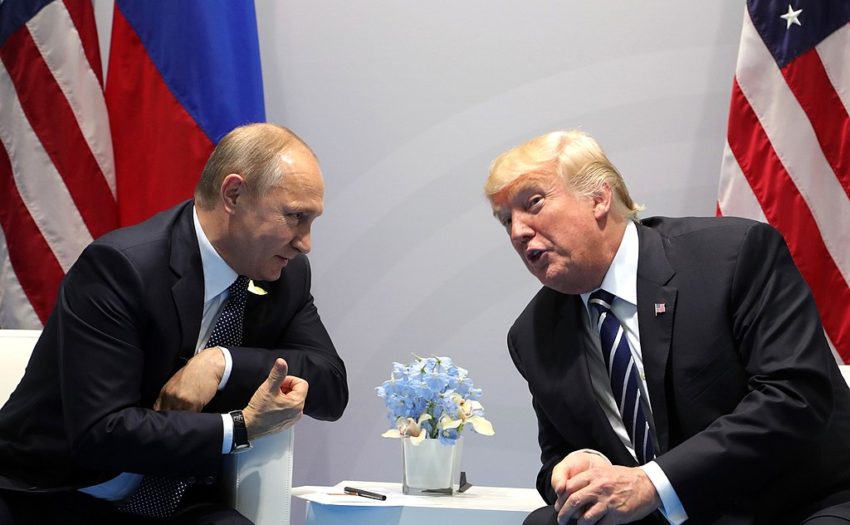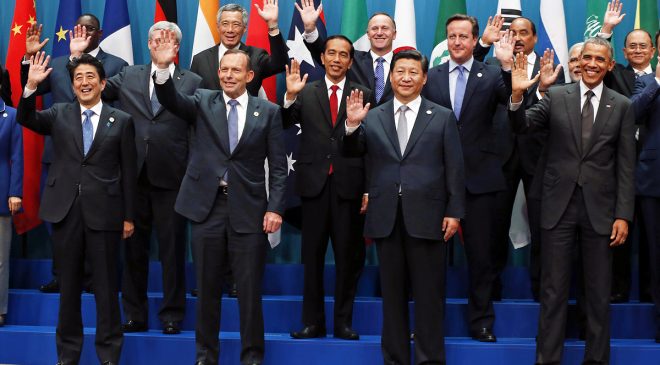The United States and Russia remained at odds, continuing military exercises along the borders of NATO, undermining the Intermediate-Range Nuclear Forces Treaty (INF), upgrading their nuclear arsenals, and eschewing arms control negotiations.
—“It’s Two Minutes to Midnight,” Bulletin of Atomic Scientists
I, for one, was much disappointed by the Trump-Putin summit — but not for the reasons most others were. I was not hoping that Trump would punch Putin in the nose or insult him or declare new sanctions. Nor was I hoping he would cancel the meeting.
Although Trump’s performance was characteristically tawdry, I don’t share the views of those who thought the meeting was a disaster because Trump didn’t throw a tantrum over Putin’s alleged order to attack American democracy by allegedly “interfering” in the 2016 election by allegedly hacking into the email accounts of Hillary Clinton and the Democratic National Committee. Allegedly. There’s a word that’s gone from the establishment media’s lexicon.
That allegation has been the subject of many claims and indictments, but claims and indictments are not evidence — and that’s what some of us still await: evidence. Amazingly, some who regard themselves as liberals and progressives think that a demand for evidence is itself evidence that the demander is on Putin’s payroll. I’ve stated my lack of fondness for Putin, which may explain why I have yet to see ruble one.
Anyway, I was disappointed in the summit because it apparently gave no great urgency to what should be the priority by the standard of security for all the people of the world: the two powers’ alarming arsenals of nuclear weapons.
I acknowledge that this subject was not completely absent from the two men’s public statements. (I can’t say what went on behind closed doors.) In their public pre-meeting sit-down Trump, to his credit, did express dismay that the US and Russia account for 90 percent of the world’s nuclear bombs. Okay, good. And during the post-meeting news conference, he repeated it: “We have 90 percent of nuclear power between the two countries.” Unfortunately, he brought this up in order to criticize the Mueller investigation into the Trump campaign’s alleged “collusion” with Russia’s alleged rigging of the 2016 election in Trump’s favor. He followed his “90 percent” statement with: “It’s ridiculous. It’s ridiculous what’s going on with the probe.” That was better than nothing, but the threatening nuclear arsenals deserve their own spotlight and should not be relegated to a reason to disparage Mueller’s dubious investigation. Putin also cited, but more vaguely, his and Trump’s deadly arsenal: “As major nuclear powers, we bear special responsibility for maintaining international security.”
What concerns me is not that nuclear weapons were ignored at the news conference, but how they were talked about. Note:
Putin: “It’s crucial that we fine-tune the dialogue on strategic stability and global security and nonproliferation of weapons of mass destruction…. It [the Iran nuclear deal, which Trump has renounced] effectively ensures the exclusively peaceful nature of the Iranian nuclear program and strengthens the nonproliferation regime.”
And Trump: “We also discussed one of the most critical challenges facing humanity: nuclear proliferation…. I think that the United States now has stepped forward, along with Russia, and we’re getting together and we have a chance to do some great things, whether it’s nuclear proliferation in terms of stopping [it], have to do it, ultimately that’s probably the most important thing that we can be working on.”
Nuclear proliferation usually means big powers stopping smaller or aspiring powers (such as Iran, which has not sought nukes, and North Korea) from acquiring or holding on to nuclear bombs. It typically does not mean Russian and US (or British, French, Chinese, Indian, Pakistani, or Israeli) bombs. But, to complicate matters, Trump saidbefore he went to Helsinki for the meeting: “I will be talking about nuclear proliferation because we are massively — you know what we’ve been doing? We’ve been modernizing and fixing and buying, and it’s just a devastating technology. And they, likewise, are doing a lot.”
So maybe they talked about their own nuclear arsenals. But if they did, why didn’t they tell us? And if they didn’t, why not?
According to the Bulletin of Atomic Scientists, “At the beginning of 2018, the US Defense Department maintained an estimated stockpile of 4,000 nuclear warheads for delivery by more than 800 ballistic missiles and aircraft.” This was a reduction from the 5,113 acknowledged in 2009. The Bulletin continued:
Most of the warheads in the stockpile are not deployed, but rather stored for potential upload onto missiles and aircraft if so decided. Many are destined for retirement. We estimate that approximately 1,800 warheads are currently deployed, of which roughly 1,650 strategic warheads are deployed on ballistic missiles and at bomber bases in the United States. Another 150 tactical bombs are deployed in Europe. The remaining warheads — approximately 2,200, or 55 percent of the total — are in storage as a so-called hedge against technical or geopolitical surprises. Several hundred of those warheads are scheduled to be retired before 2030.
In addition to the warheads in the Defense Department stockpile, approximately 2,550 retired but still intact warheads are stored under custody of the Energy Department and are awaiting dismantlement, for a total US inventory of roughly 6,550 warheads.
As we can see, there have been welcome reductions. The Bulletin attributes the reduction in part to the New START Treaty, which took effect in 2011 and will expire in 2021 but can be extended for five more years. However, it wouldn’t take many of those warheads to destroy the world.
So let’s not pop the champagne just yet. For one thing, the US has missiles on high alert, which Barack Obama expressed concern over when he ran for president in 2008 but did nothing about. His lack of action prompted a group of scientists to write Obama in 2016, urging him to “take U.S. land-based missiles off hair-trigger alert and to remove from U.S. war plans the option of launching these weapons on warning. The United States should encourage Russia to follow suit, but it should not wait to act.” The letter noted that “in 1991, President George H.W. Bush took one leg of the U.S. nuclear triad — bombers — off high alert. The time is right to remove a second leg — land-based missiles — from high alert.” (See “The US still keeps hundreds of nuclear weapons on hair-trigger alert — here’s what it means and why it’s a huge risk” and “Reducing the Risk of Nuclear War.”)
What about the Russian arsenal? The Bulletin of Atomic Scientists writes:
As of early 2018, we estimate that Russia has a stockpile of roughly 4,350 nuclear warheads assigned for use by long-range strategic launchers and shorter-range tactical nuclear forces. Of these, roughly 1,600 strategic warheads are deployed on ballistic missiles and at heavy bomber bases, while another 920 strategic warheads are in storage along with about 1,830 non-strategic warheads. In addition to the military stockpile for operational forces, a large number — perhaps almost 2,500 — of retired but still largely intact warheads await dismantlement, for a total inventory of more than 6,850 warheads.
During the past year, Russia significantly reduced the number of warheads deployed on its ballistic missiles to meet the New START limit of no more than 1,550 deployed strategic warheads. Russia had achieved the required reduction by 5 February 2018, when it declared 1,444 deployed strategic warheads attributed to 527 deployed strategic launchers…. The numbers indicate that Russia has reduced the warhead loading on some of its missiles to below what is normally assumed…. This shows that New START puts real constraints on Russia’s deployed strategic forces. The result appears to be an increased reliance on a strategic reserve of non-deployed warheads that can be loaded onto missiles in a crisis to increase the size of the force, a strategy similar to the one the United States has relied on for several decades.
The US and Russia have been modernizing their arsenals, but the US has a distinct advantage because it is so much wealthier. The Bulletin notes that
Overall, Russia’s nuclear modernization effort will present the international arms control community with new challenges. Unless a new arms reduction agreement is reached in the near future, the shrinking of Russia’s strategic nuclear arsenal that has characterized the past two decades will likely come to an end, with the force leveling out at around 530 launchers with roughly 2,500 assigned warheads. But Russia’s financial crisis represents a significant challenge to maintaining even that force level, as exemplified by the delays of several major weapon systems, like the small ICBM (SS-28) and the rail-based ICBM.
The US spends far more on its military than Russia does. Indeed, the recent increase in military spending ($61 billion) exceeded Russia’s entire military budget ($47 billion).
Nevertheless, at the moment the two active arsenals are about the same size, and even though they have shrunk, they are still capable of wreaking havoc with humanity. Anti-missile technology could make this balance more apparent than real. The US left the Anti-Ballistic Missile Treaty in 2001 and has both worked on an ABM system and talked about deploying it in Europe. If such a system really worked (a big if), it would give the US an advantage over Russia because missile a defense could obviously be used offensively by ending the old MAD (mutually assured destruction) approach, which has deterred each side from using their nukes for about 70 years. For its part, Russia claimsto have developed missiles that can evade anti-missile systems.
At any rate, the destructive power of the two powers’ remaining arsenals demands that Trump and Putin should be talking about at least dramatically reducing the size of the stockpiles and reducing the chance of accidental nuclear war. As noted, New START, under which the two countries also halved their arsenals of strategic nuclear missile launchers, will expire in 2021. Will it be extended?
Fox News reported that Putin told Trump that “Russia stands ready to extend this treaty, to prolong it, but we have to agree on the specifics at first.” Putin said that “we have some questions to our American partners [because] we think that they are not fully compliant with the treaty, but this is for experts to decide.”
How about Trump? Reuters reported last year:
In his first call as president with Russian leader Vladimir Putin, Donald Trump denounced a treaty that caps U.S. and Russian deployment of nuclear warheads as a bad deal for the United States, according to two U.S. officials and one former U.S. official with knowledge of the call.
When Putin raised the possibility of extending the 2010 treaty, known as New START, Trump paused to ask his aides in an aside what the treaty was, these sources said.
Trump then told Putin the treaty was one of several bad deals negotiated by the Obama administration, saying that New START favored Russia.
Trump’s making nice with Putin at a summit cannot overshadow what is really going on. Under Trump, NATO, whose rai·son d’ê·tre is Russia and which continues to expand, has troops on Russia’s border. Trump has authorized the provision of lethal aid to Ukraine, something Obama opposed. Trump is militarily engaged, uninvited, in Syria, a Russian ally. Trump is ginning up hostility toward Iran, a Russian ally. Trump has approved new sanctions on Russia and has expelled diplomats. The climate is not good, although it’s apparently too good for Trump’s so-called liberal and progressive antagonists.
The danger that nuclear weapons could be deployed in a US-Russian clash lies not merely in their intentional use. It lies also in their use at the end of a series of mishaps and misunderstandings. Just because we’ve been lucky since 1945 (when the US dropped the first atomic bombs) does not mean we will always be lucky. The big powers should have no higher aim than to reduce — on the way toward eliminating — this threat.
Trump’s boastful militarism and fascination with weaponry should make us all nervous. He likes to say he understands the destructiveness of nuclear bombs, but where Russia is concerned, he does nothing to inspire confidence that he wants to reduce the chances of war.




